Google Glass: Examining Utility, Impact, User Adoption & Perceptions
VerifiedAdded on 2023/06/03
|10
|2349
|275
Essay
AI Summary
This essay delves into the impact and utility of Google Glass, examining its applications across various fields. It explores the use of Google Glass in augmented reality (AR) assisted surgery, highlighting its potential as a training tool for urology residents and its effectiveness in orthopaedic and plastic surgery. The essay also discusses the feasibility of AR in clinical simulations, noting students' positive experiences and recommendations for future use, despite some usability and technical challenges. Furthermore, it investigates users' attitudes toward social interaction assistance provided by Google Glass, revealing appreciation for the technology and its potential for improving routine communications. The essay also touches upon the 'fashnology' perspective, considering whether smart glasses are perceived as technology or fashion accessories, and how this perception influences adoption. Ultimately, the essay concludes that Google Glass and similar wearable technologies have a significant impact on various sectors, offering solutions to problems and enhancing work efficiency.
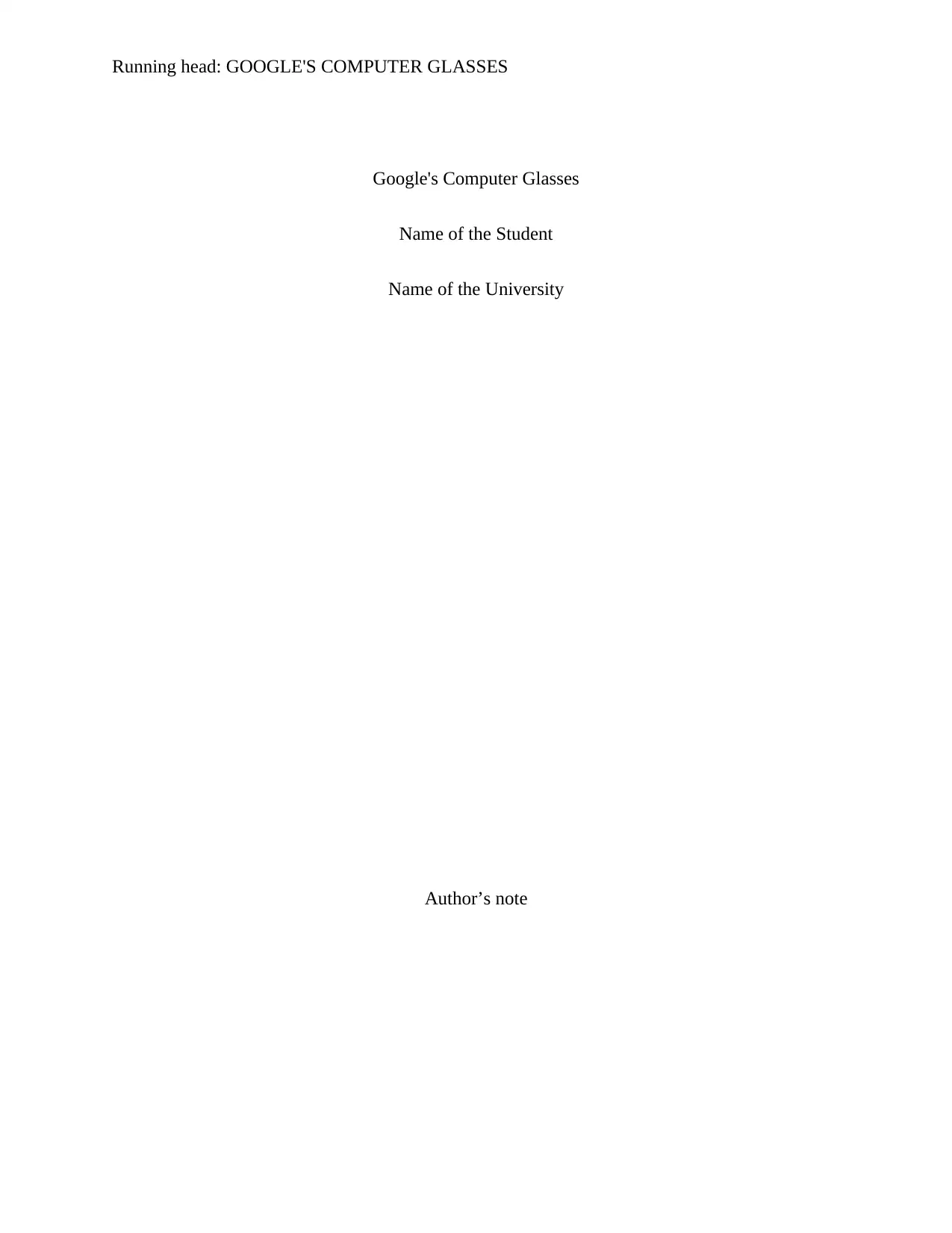
Running head: GOOGLE'S COMPUTER GLASSES
Google's Computer Glasses
Name of the Student
Name of the University
Author’s note
Google's Computer Glasses
Name of the Student
Name of the University
Author’s note
Paraphrase This Document
Need a fresh take? Get an instant paraphrase of this document with our AI Paraphraser

1GOOGLE'S COMPUTER GLASSES
Table of Contents
1. Introduction..................................................................................................................................2
2. Discussion....................................................................................................................................2
2.1 Arguments on the Impact of Google Glass............................................................................2
3. Conclusion...................................................................................................................................7
4. References....................................................................................................................................8
Table of Contents
1. Introduction..................................................................................................................................2
2. Discussion....................................................................................................................................2
2.1 Arguments on the Impact of Google Glass............................................................................2
3. Conclusion...................................................................................................................................7
4. References....................................................................................................................................8
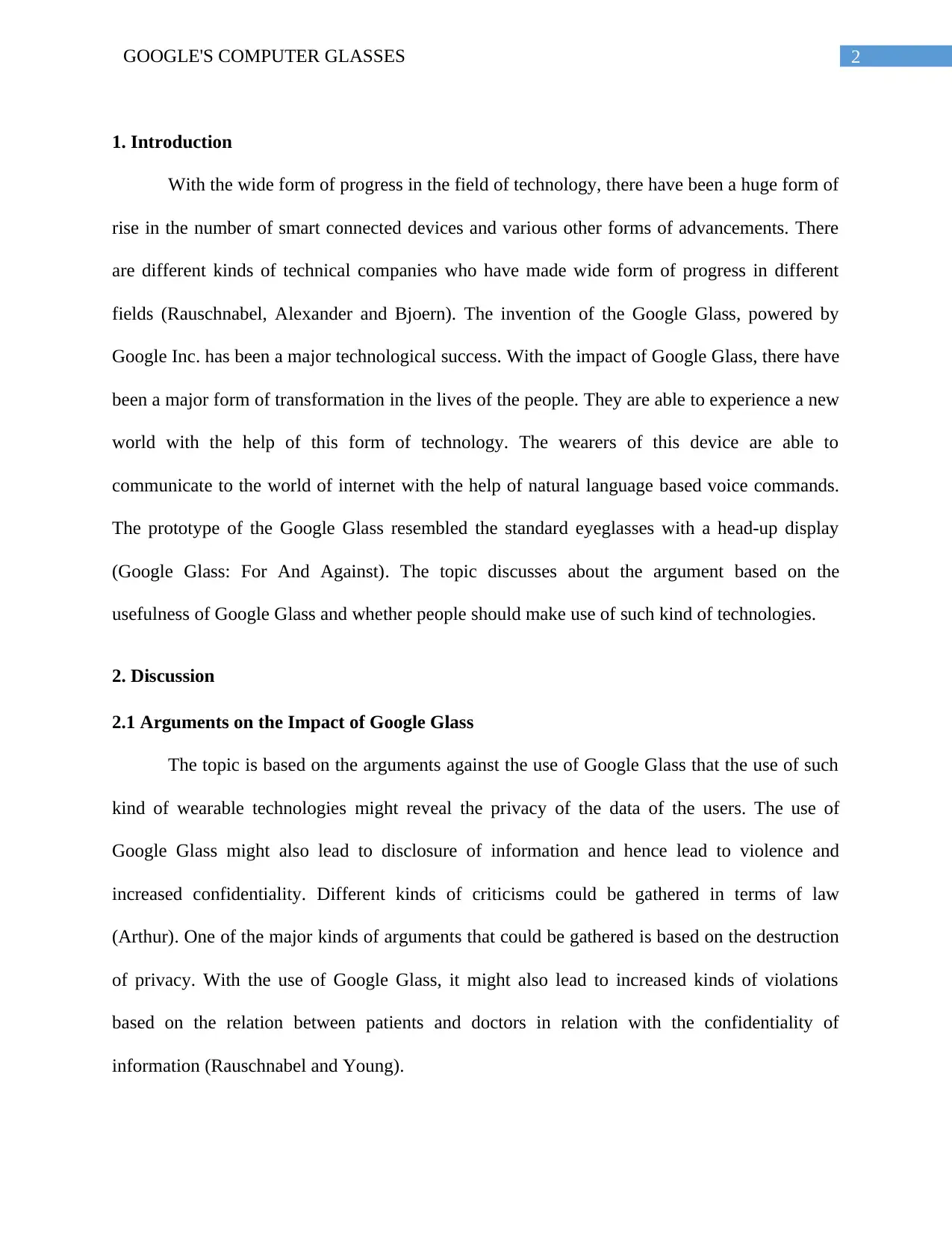
2GOOGLE'S COMPUTER GLASSES
1. Introduction
With the wide form of progress in the field of technology, there have been a huge form of
rise in the number of smart connected devices and various other forms of advancements. There
are different kinds of technical companies who have made wide form of progress in different
fields (Rauschnabel, Alexander and Bjoern). The invention of the Google Glass, powered by
Google Inc. has been a major technological success. With the impact of Google Glass, there have
been a major form of transformation in the lives of the people. They are able to experience a new
world with the help of this form of technology. The wearers of this device are able to
communicate to the world of internet with the help of natural language based voice commands.
The prototype of the Google Glass resembled the standard eyeglasses with a head-up display
(Google Glass: For And Against). The topic discusses about the argument based on the
usefulness of Google Glass and whether people should make use of such kind of technologies.
2. Discussion
2.1 Arguments on the Impact of Google Glass
The topic is based on the arguments against the use of Google Glass that the use of such
kind of wearable technologies might reveal the privacy of the data of the users. The use of
Google Glass might also lead to disclosure of information and hence lead to violence and
increased confidentiality. Different kinds of criticisms could be gathered in terms of law
(Arthur). One of the major kinds of arguments that could be gathered is based on the destruction
of privacy. With the use of Google Glass, it might also lead to increased kinds of violations
based on the relation between patients and doctors in relation with the confidentiality of
information (Rauschnabel and Young).
1. Introduction
With the wide form of progress in the field of technology, there have been a huge form of
rise in the number of smart connected devices and various other forms of advancements. There
are different kinds of technical companies who have made wide form of progress in different
fields (Rauschnabel, Alexander and Bjoern). The invention of the Google Glass, powered by
Google Inc. has been a major technological success. With the impact of Google Glass, there have
been a major form of transformation in the lives of the people. They are able to experience a new
world with the help of this form of technology. The wearers of this device are able to
communicate to the world of internet with the help of natural language based voice commands.
The prototype of the Google Glass resembled the standard eyeglasses with a head-up display
(Google Glass: For And Against). The topic discusses about the argument based on the
usefulness of Google Glass and whether people should make use of such kind of technologies.
2. Discussion
2.1 Arguments on the Impact of Google Glass
The topic is based on the arguments against the use of Google Glass that the use of such
kind of wearable technologies might reveal the privacy of the data of the users. The use of
Google Glass might also lead to disclosure of information and hence lead to violence and
increased confidentiality. Different kinds of criticisms could be gathered in terms of law
(Arthur). One of the major kinds of arguments that could be gathered is based on the destruction
of privacy. With the use of Google Glass, it might also lead to increased kinds of violations
based on the relation between patients and doctors in relation with the confidentiality of
information (Rauschnabel and Young).
⊘ This is a preview!⊘
Do you want full access?
Subscribe today to unlock all pages.

Trusted by 1+ million students worldwide
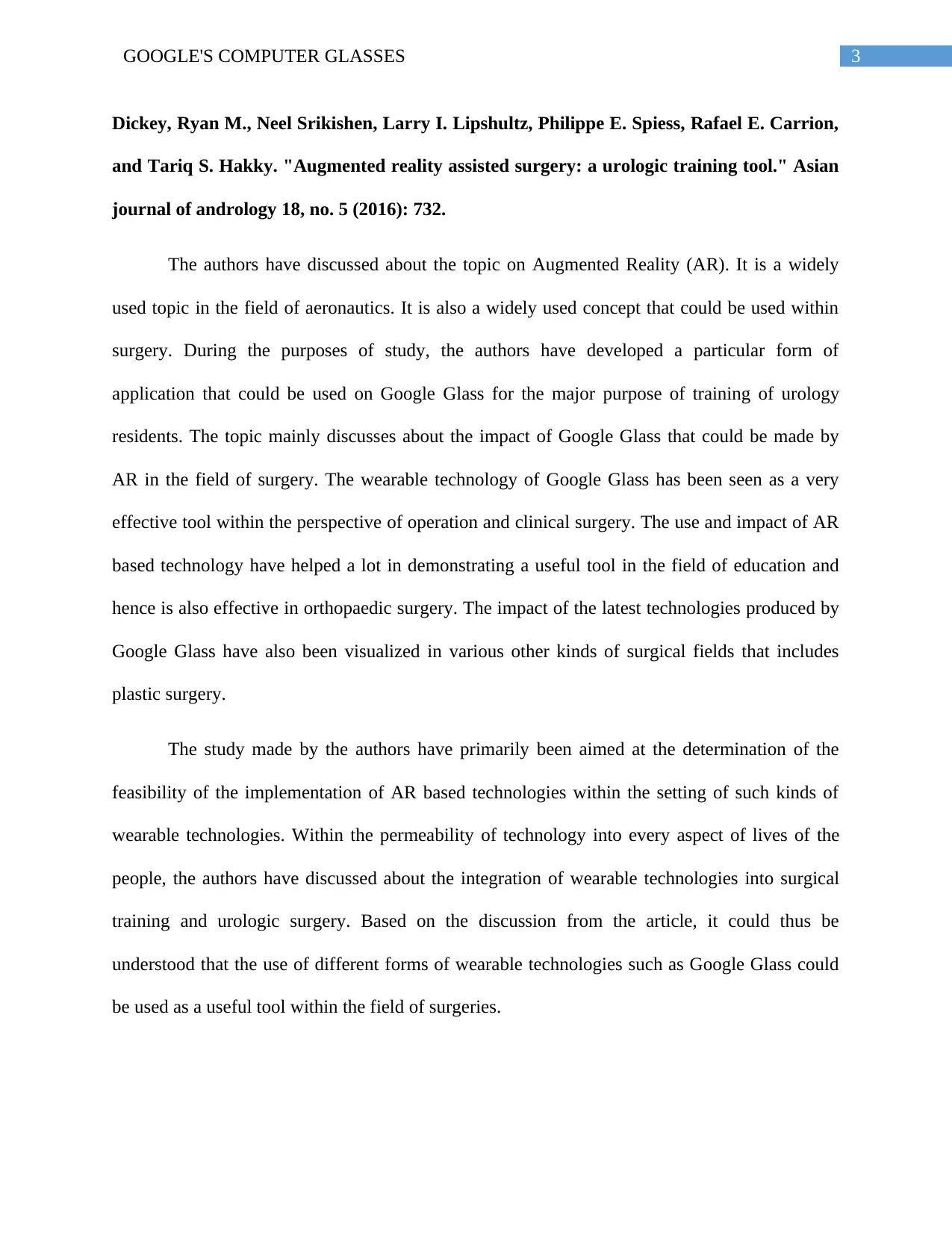
3GOOGLE'S COMPUTER GLASSES
Dickey, Ryan M., Neel Srikishen, Larry I. Lipshultz, Philippe E. Spiess, Rafael E. Carrion,
and Tariq S. Hakky. "Augmented reality assisted surgery: a urologic training tool." Asian
journal of andrology 18, no. 5 (2016): 732.
The authors have discussed about the topic on Augmented Reality (AR). It is a widely
used topic in the field of aeronautics. It is also a widely used concept that could be used within
surgery. During the purposes of study, the authors have developed a particular form of
application that could be used on Google Glass for the major purpose of training of urology
residents. The topic mainly discusses about the impact of Google Glass that could be made by
AR in the field of surgery. The wearable technology of Google Glass has been seen as a very
effective tool within the perspective of operation and clinical surgery. The use and impact of AR
based technology have helped a lot in demonstrating a useful tool in the field of education and
hence is also effective in orthopaedic surgery. The impact of the latest technologies produced by
Google Glass have also been visualized in various other kinds of surgical fields that includes
plastic surgery.
The study made by the authors have primarily been aimed at the determination of the
feasibility of the implementation of AR based technologies within the setting of such kinds of
wearable technologies. Within the permeability of technology into every aspect of lives of the
people, the authors have discussed about the integration of wearable technologies into surgical
training and urologic surgery. Based on the discussion from the article, it could thus be
understood that the use of different forms of wearable technologies such as Google Glass could
be used as a useful tool within the field of surgeries.
Dickey, Ryan M., Neel Srikishen, Larry I. Lipshultz, Philippe E. Spiess, Rafael E. Carrion,
and Tariq S. Hakky. "Augmented reality assisted surgery: a urologic training tool." Asian
journal of andrology 18, no. 5 (2016): 732.
The authors have discussed about the topic on Augmented Reality (AR). It is a widely
used topic in the field of aeronautics. It is also a widely used concept that could be used within
surgery. During the purposes of study, the authors have developed a particular form of
application that could be used on Google Glass for the major purpose of training of urology
residents. The topic mainly discusses about the impact of Google Glass that could be made by
AR in the field of surgery. The wearable technology of Google Glass has been seen as a very
effective tool within the perspective of operation and clinical surgery. The use and impact of AR
based technology have helped a lot in demonstrating a useful tool in the field of education and
hence is also effective in orthopaedic surgery. The impact of the latest technologies produced by
Google Glass have also been visualized in various other kinds of surgical fields that includes
plastic surgery.
The study made by the authors have primarily been aimed at the determination of the
feasibility of the implementation of AR based technologies within the setting of such kinds of
wearable technologies. Within the permeability of technology into every aspect of lives of the
people, the authors have discussed about the integration of wearable technologies into surgical
training and urologic surgery. Based on the discussion from the article, it could thus be
understood that the use of different forms of wearable technologies such as Google Glass could
be used as a useful tool within the field of surgeries.
Paraphrase This Document
Need a fresh take? Get an instant paraphrase of this document with our AI Paraphraser
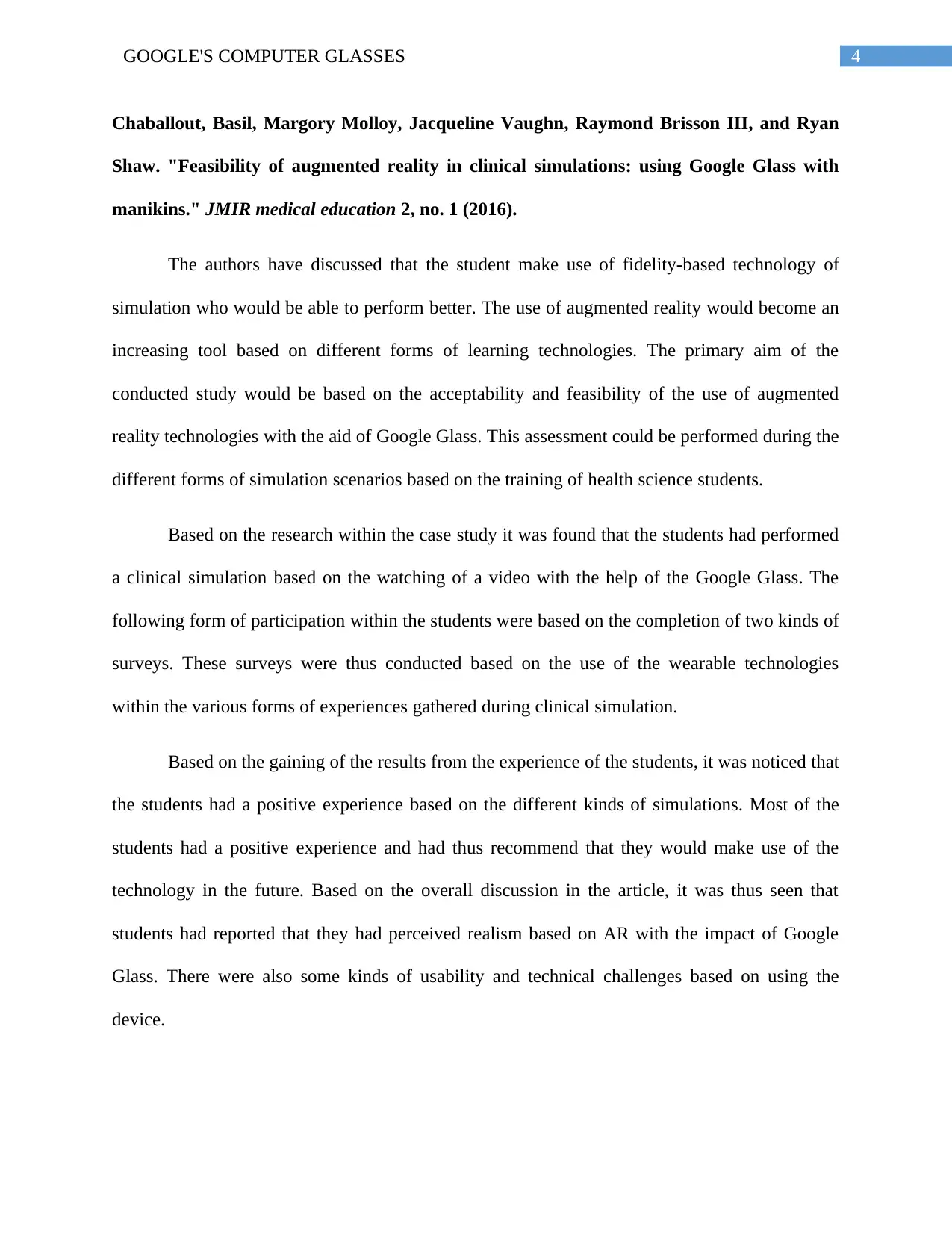
4GOOGLE'S COMPUTER GLASSES
Chaballout, Basil, Margory Molloy, Jacqueline Vaughn, Raymond Brisson III, and Ryan
Shaw. "Feasibility of augmented reality in clinical simulations: using Google Glass with
manikins." JMIR medical education 2, no. 1 (2016).
The authors have discussed that the student make use of fidelity-based technology of
simulation who would be able to perform better. The use of augmented reality would become an
increasing tool based on different forms of learning technologies. The primary aim of the
conducted study would be based on the acceptability and feasibility of the use of augmented
reality technologies with the aid of Google Glass. This assessment could be performed during the
different forms of simulation scenarios based on the training of health science students.
Based on the research within the case study it was found that the students had performed
a clinical simulation based on the watching of a video with the help of the Google Glass. The
following form of participation within the students were based on the completion of two kinds of
surveys. These surveys were thus conducted based on the use of the wearable technologies
within the various forms of experiences gathered during clinical simulation.
Based on the gaining of the results from the experience of the students, it was noticed that
the students had a positive experience based on the different kinds of simulations. Most of the
students had a positive experience and had thus recommend that they would make use of the
technology in the future. Based on the overall discussion in the article, it was thus seen that
students had reported that they had perceived realism based on AR with the impact of Google
Glass. There were also some kinds of usability and technical challenges based on using the
device.
Chaballout, Basil, Margory Molloy, Jacqueline Vaughn, Raymond Brisson III, and Ryan
Shaw. "Feasibility of augmented reality in clinical simulations: using Google Glass with
manikins." JMIR medical education 2, no. 1 (2016).
The authors have discussed that the student make use of fidelity-based technology of
simulation who would be able to perform better. The use of augmented reality would become an
increasing tool based on different forms of learning technologies. The primary aim of the
conducted study would be based on the acceptability and feasibility of the use of augmented
reality technologies with the aid of Google Glass. This assessment could be performed during the
different forms of simulation scenarios based on the training of health science students.
Based on the research within the case study it was found that the students had performed
a clinical simulation based on the watching of a video with the help of the Google Glass. The
following form of participation within the students were based on the completion of two kinds of
surveys. These surveys were thus conducted based on the use of the wearable technologies
within the various forms of experiences gathered during clinical simulation.
Based on the gaining of the results from the experience of the students, it was noticed that
the students had a positive experience based on the different kinds of simulations. Most of the
students had a positive experience and had thus recommend that they would make use of the
technology in the future. Based on the overall discussion in the article, it was thus seen that
students had reported that they had perceived realism based on AR with the impact of Google
Glass. There were also some kinds of usability and technical challenges based on using the
device.
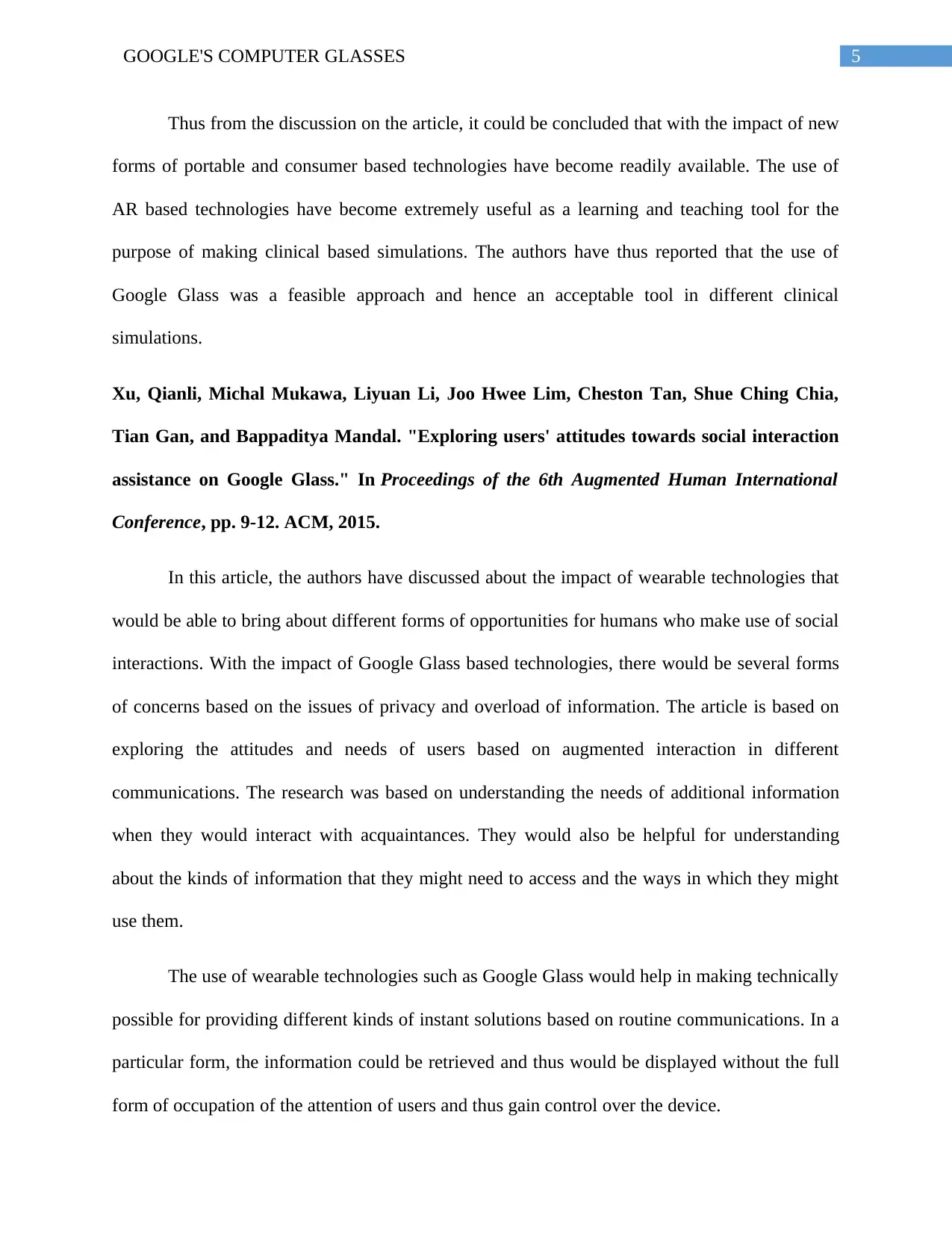
5GOOGLE'S COMPUTER GLASSES
Thus from the discussion on the article, it could be concluded that with the impact of new
forms of portable and consumer based technologies have become readily available. The use of
AR based technologies have become extremely useful as a learning and teaching tool for the
purpose of making clinical based simulations. The authors have thus reported that the use of
Google Glass was a feasible approach and hence an acceptable tool in different clinical
simulations.
Xu, Qianli, Michal Mukawa, Liyuan Li, Joo Hwee Lim, Cheston Tan, Shue Ching Chia,
Tian Gan, and Bappaditya Mandal. "Exploring users' attitudes towards social interaction
assistance on Google Glass." In Proceedings of the 6th Augmented Human International
Conference, pp. 9-12. ACM, 2015.
In this article, the authors have discussed about the impact of wearable technologies that
would be able to bring about different forms of opportunities for humans who make use of social
interactions. With the impact of Google Glass based technologies, there would be several forms
of concerns based on the issues of privacy and overload of information. The article is based on
exploring the attitudes and needs of users based on augmented interaction in different
communications. The research was based on understanding the needs of additional information
when they would interact with acquaintances. They would also be helpful for understanding
about the kinds of information that they might need to access and the ways in which they might
use them.
The use of wearable technologies such as Google Glass would help in making technically
possible for providing different kinds of instant solutions based on routine communications. In a
particular form, the information could be retrieved and thus would be displayed without the full
form of occupation of the attention of users and thus gain control over the device.
Thus from the discussion on the article, it could be concluded that with the impact of new
forms of portable and consumer based technologies have become readily available. The use of
AR based technologies have become extremely useful as a learning and teaching tool for the
purpose of making clinical based simulations. The authors have thus reported that the use of
Google Glass was a feasible approach and hence an acceptable tool in different clinical
simulations.
Xu, Qianli, Michal Mukawa, Liyuan Li, Joo Hwee Lim, Cheston Tan, Shue Ching Chia,
Tian Gan, and Bappaditya Mandal. "Exploring users' attitudes towards social interaction
assistance on Google Glass." In Proceedings of the 6th Augmented Human International
Conference, pp. 9-12. ACM, 2015.
In this article, the authors have discussed about the impact of wearable technologies that
would be able to bring about different forms of opportunities for humans who make use of social
interactions. With the impact of Google Glass based technologies, there would be several forms
of concerns based on the issues of privacy and overload of information. The article is based on
exploring the attitudes and needs of users based on augmented interaction in different
communications. The research was based on understanding the needs of additional information
when they would interact with acquaintances. They would also be helpful for understanding
about the kinds of information that they might need to access and the ways in which they might
use them.
The use of wearable technologies such as Google Glass would help in making technically
possible for providing different kinds of instant solutions based on routine communications. In a
particular form, the information could be retrieved and thus would be displayed without the full
form of occupation of the attention of users and thus gain control over the device.
⊘ This is a preview!⊘
Do you want full access?
Subscribe today to unlock all pages.

Trusted by 1+ million students worldwide
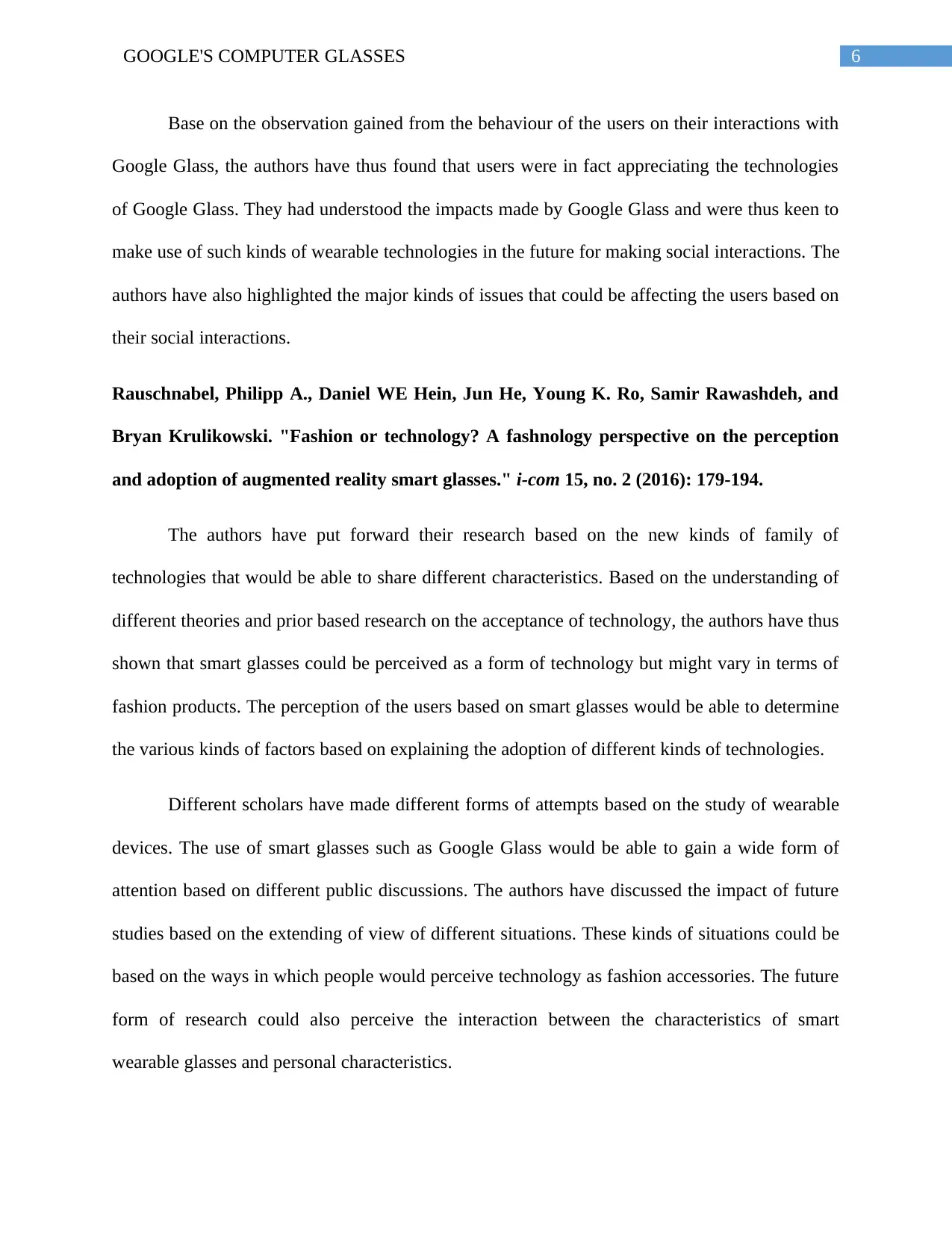
6GOOGLE'S COMPUTER GLASSES
Base on the observation gained from the behaviour of the users on their interactions with
Google Glass, the authors have thus found that users were in fact appreciating the technologies
of Google Glass. They had understood the impacts made by Google Glass and were thus keen to
make use of such kinds of wearable technologies in the future for making social interactions. The
authors have also highlighted the major kinds of issues that could be affecting the users based on
their social interactions.
Rauschnabel, Philipp A., Daniel WE Hein, Jun He, Young K. Ro, Samir Rawashdeh, and
Bryan Krulikowski. "Fashion or technology? A fashnology perspective on the perception
and adoption of augmented reality smart glasses." i-com 15, no. 2 (2016): 179-194.
The authors have put forward their research based on the new kinds of family of
technologies that would be able to share different characteristics. Based on the understanding of
different theories and prior based research on the acceptance of technology, the authors have thus
shown that smart glasses could be perceived as a form of technology but might vary in terms of
fashion products. The perception of the users based on smart glasses would be able to determine
the various kinds of factors based on explaining the adoption of different kinds of technologies.
Different scholars have made different forms of attempts based on the study of wearable
devices. The use of smart glasses such as Google Glass would be able to gain a wide form of
attention based on different public discussions. The authors have discussed the impact of future
studies based on the extending of view of different situations. These kinds of situations could be
based on the ways in which people would perceive technology as fashion accessories. The future
form of research could also perceive the interaction between the characteristics of smart
wearable glasses and personal characteristics.
Base on the observation gained from the behaviour of the users on their interactions with
Google Glass, the authors have thus found that users were in fact appreciating the technologies
of Google Glass. They had understood the impacts made by Google Glass and were thus keen to
make use of such kinds of wearable technologies in the future for making social interactions. The
authors have also highlighted the major kinds of issues that could be affecting the users based on
their social interactions.
Rauschnabel, Philipp A., Daniel WE Hein, Jun He, Young K. Ro, Samir Rawashdeh, and
Bryan Krulikowski. "Fashion or technology? A fashnology perspective on the perception
and adoption of augmented reality smart glasses." i-com 15, no. 2 (2016): 179-194.
The authors have put forward their research based on the new kinds of family of
technologies that would be able to share different characteristics. Based on the understanding of
different theories and prior based research on the acceptance of technology, the authors have thus
shown that smart glasses could be perceived as a form of technology but might vary in terms of
fashion products. The perception of the users based on smart glasses would be able to determine
the various kinds of factors based on explaining the adoption of different kinds of technologies.
Different scholars have made different forms of attempts based on the study of wearable
devices. The use of smart glasses such as Google Glass would be able to gain a wide form of
attention based on different public discussions. The authors have discussed the impact of future
studies based on the extending of view of different situations. These kinds of situations could be
based on the ways in which people would perceive technology as fashion accessories. The future
form of research could also perceive the interaction between the characteristics of smart
wearable glasses and personal characteristics.
Paraphrase This Document
Need a fresh take? Get an instant paraphrase of this document with our AI Paraphraser
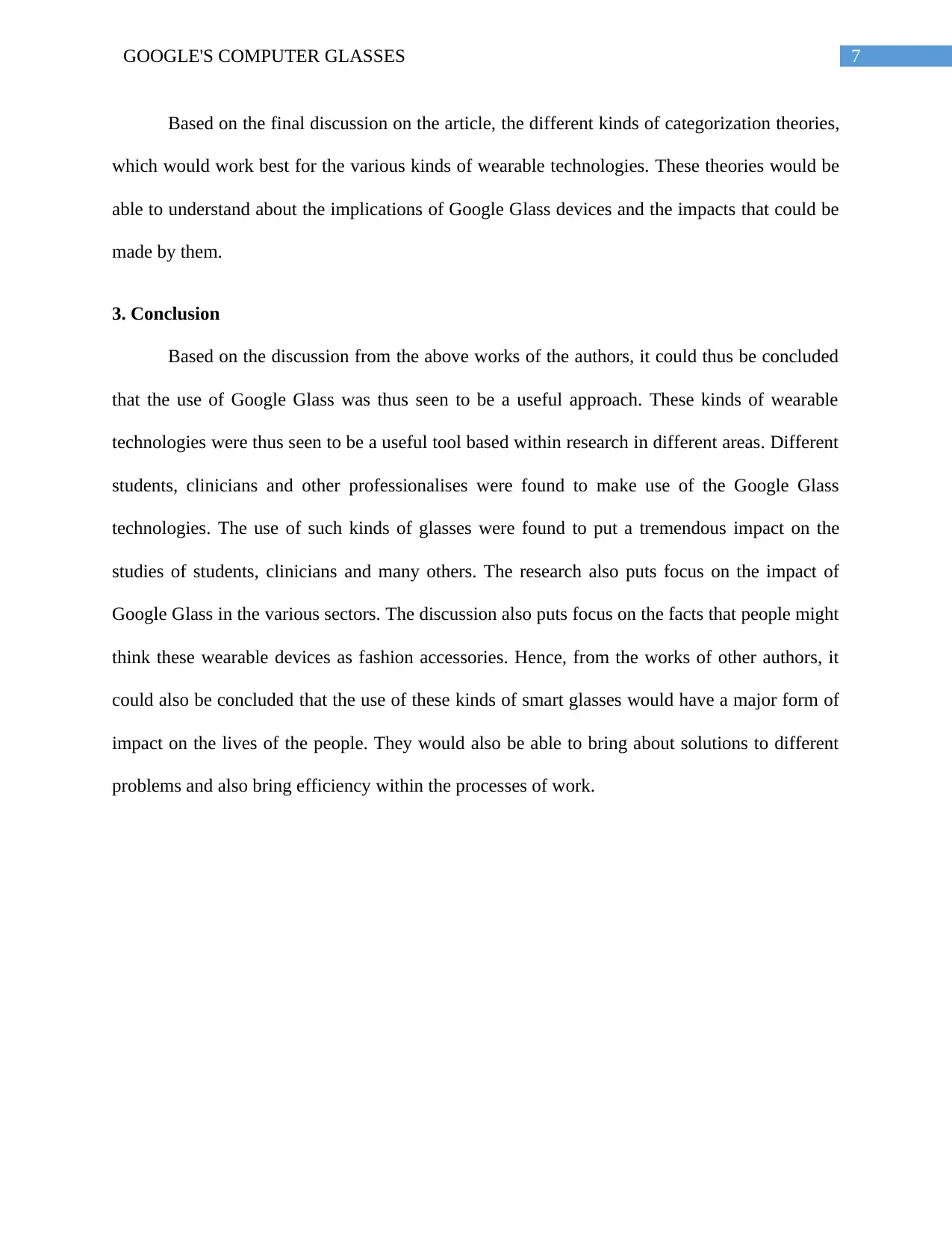
7GOOGLE'S COMPUTER GLASSES
Based on the final discussion on the article, the different kinds of categorization theories,
which would work best for the various kinds of wearable technologies. These theories would be
able to understand about the implications of Google Glass devices and the impacts that could be
made by them.
3. Conclusion
Based on the discussion from the above works of the authors, it could thus be concluded
that the use of Google Glass was thus seen to be a useful approach. These kinds of wearable
technologies were thus seen to be a useful tool based within research in different areas. Different
students, clinicians and other professionalises were found to make use of the Google Glass
technologies. The use of such kinds of glasses were found to put a tremendous impact on the
studies of students, clinicians and many others. The research also puts focus on the impact of
Google Glass in the various sectors. The discussion also puts focus on the facts that people might
think these wearable devices as fashion accessories. Hence, from the works of other authors, it
could also be concluded that the use of these kinds of smart glasses would have a major form of
impact on the lives of the people. They would also be able to bring about solutions to different
problems and also bring efficiency within the processes of work.
Based on the final discussion on the article, the different kinds of categorization theories,
which would work best for the various kinds of wearable technologies. These theories would be
able to understand about the implications of Google Glass devices and the impacts that could be
made by them.
3. Conclusion
Based on the discussion from the above works of the authors, it could thus be concluded
that the use of Google Glass was thus seen to be a useful approach. These kinds of wearable
technologies were thus seen to be a useful tool based within research in different areas. Different
students, clinicians and other professionalises were found to make use of the Google Glass
technologies. The use of such kinds of glasses were found to put a tremendous impact on the
studies of students, clinicians and many others. The research also puts focus on the impact of
Google Glass in the various sectors. The discussion also puts focus on the facts that people might
think these wearable devices as fashion accessories. Hence, from the works of other authors, it
could also be concluded that the use of these kinds of smart glasses would have a major form of
impact on the lives of the people. They would also be able to bring about solutions to different
problems and also bring efficiency within the processes of work.

8GOOGLE'S COMPUTER GLASSES
4. References
"Google Glass: For And Against." BBC News. N.p., 2018. Web. 25 Oct. 2018.
Arthur, Charles. "Google Glass: Is It A Threat To Our Privacy?." the Guardian. N.p., 2018.
Web. 25 Oct. 2018.
Chaballout, Basil, Margory Molloy, Jacqueline Vaughn, Raymond Brisson III, and Ryan Shaw.
"Feasibility of augmented reality in clinical simulations: using Google Glass with manikins."
JMIR medical education 2, no. 1 (2016).
Dickey, Ryan M., Neel Srikishen, Larry I. Lipshultz, Philippe E. Spiess, Rafael E. Carrion, and
Tariq S. Hakky. "Augmented reality assisted surgery: a urologic training tool." Asian journal of
andrology 18, no. 5 (2016): 732.
Rauschnabel, Philipp A., Alexander Brem, and Bjoern S. Ivens. "Who will buy smart glasses?
Empirical results of two pre-market-entry studies on the role of personality in individual
awareness and intended adoption of Google Glass wearables." Computers in Human Behavior 49
(2015): 635-647.
Rauschnabel, Philipp A., and Young K. Ro. "Augmented reality smart glasses: An investigation
of technology acceptance drivers." International Journal of Technology Marketing 11, no. 2
(2016): 123-148.
Rauschnabel, Philipp A., Daniel WE Hein, Jun He, Young K. Ro, Samir Rawashdeh, and Bryan
Krulikowski. "Fashion or technology? A fashnology perspective on the perception and adoption
of augmented reality smart glasses." i-com 15, no. 2 (2016): 179-194.
4. References
"Google Glass: For And Against." BBC News. N.p., 2018. Web. 25 Oct. 2018.
Arthur, Charles. "Google Glass: Is It A Threat To Our Privacy?." the Guardian. N.p., 2018.
Web. 25 Oct. 2018.
Chaballout, Basil, Margory Molloy, Jacqueline Vaughn, Raymond Brisson III, and Ryan Shaw.
"Feasibility of augmented reality in clinical simulations: using Google Glass with manikins."
JMIR medical education 2, no. 1 (2016).
Dickey, Ryan M., Neel Srikishen, Larry I. Lipshultz, Philippe E. Spiess, Rafael E. Carrion, and
Tariq S. Hakky. "Augmented reality assisted surgery: a urologic training tool." Asian journal of
andrology 18, no. 5 (2016): 732.
Rauschnabel, Philipp A., Alexander Brem, and Bjoern S. Ivens. "Who will buy smart glasses?
Empirical results of two pre-market-entry studies on the role of personality in individual
awareness and intended adoption of Google Glass wearables." Computers in Human Behavior 49
(2015): 635-647.
Rauschnabel, Philipp A., and Young K. Ro. "Augmented reality smart glasses: An investigation
of technology acceptance drivers." International Journal of Technology Marketing 11, no. 2
(2016): 123-148.
Rauschnabel, Philipp A., Daniel WE Hein, Jun He, Young K. Ro, Samir Rawashdeh, and Bryan
Krulikowski. "Fashion or technology? A fashnology perspective on the perception and adoption
of augmented reality smart glasses." i-com 15, no. 2 (2016): 179-194.
⊘ This is a preview!⊘
Do you want full access?
Subscribe today to unlock all pages.

Trusted by 1+ million students worldwide
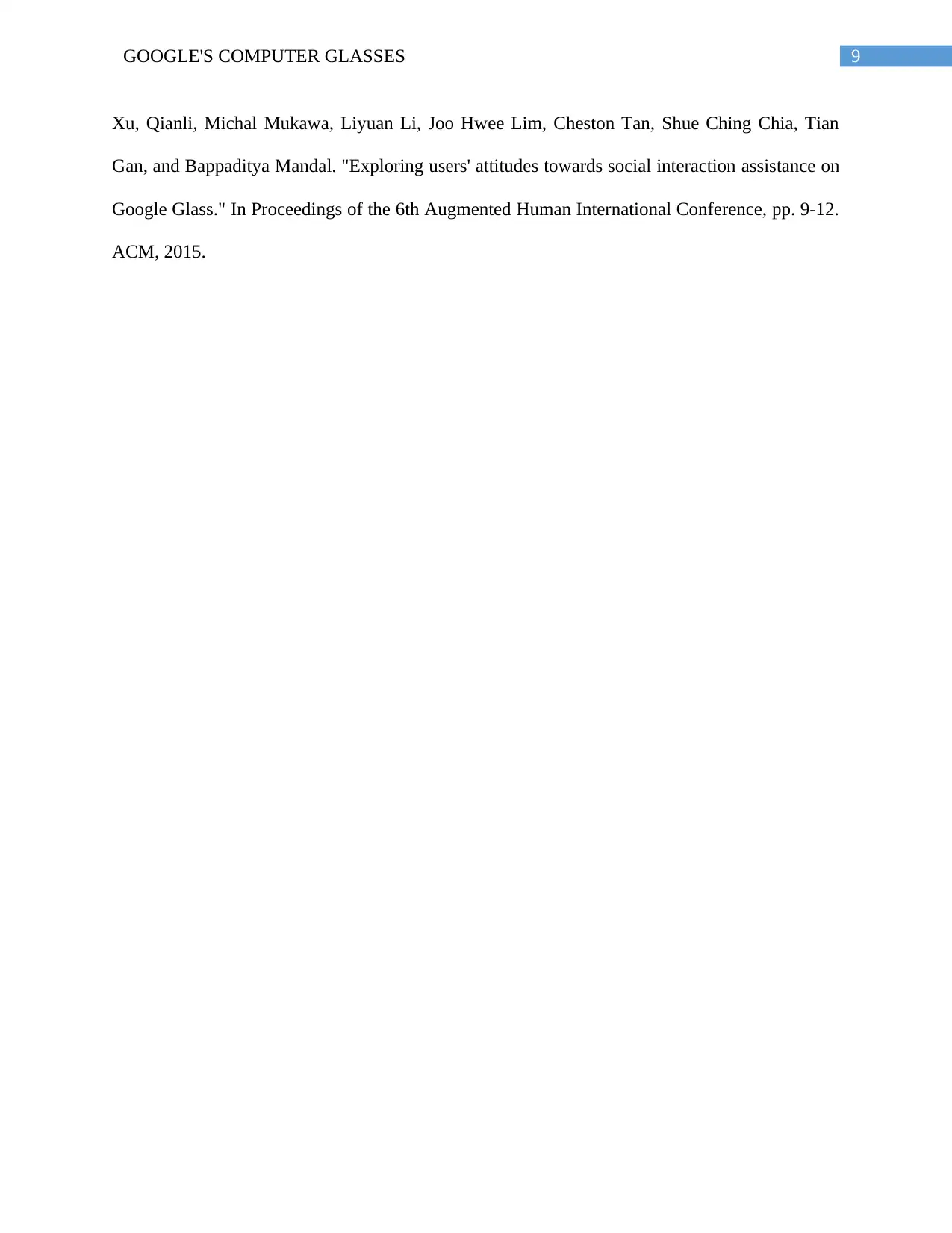
9GOOGLE'S COMPUTER GLASSES
Xu, Qianli, Michal Mukawa, Liyuan Li, Joo Hwee Lim, Cheston Tan, Shue Ching Chia, Tian
Gan, and Bappaditya Mandal. "Exploring users' attitudes towards social interaction assistance on
Google Glass." In Proceedings of the 6th Augmented Human International Conference, pp. 9-12.
ACM, 2015.
Xu, Qianli, Michal Mukawa, Liyuan Li, Joo Hwee Lim, Cheston Tan, Shue Ching Chia, Tian
Gan, and Bappaditya Mandal. "Exploring users' attitudes towards social interaction assistance on
Google Glass." In Proceedings of the 6th Augmented Human International Conference, pp. 9-12.
ACM, 2015.
1 out of 10
Related Documents
Your All-in-One AI-Powered Toolkit for Academic Success.
+13062052269
info@desklib.com
Available 24*7 on WhatsApp / Email
![[object Object]](/_next/static/media/star-bottom.7253800d.svg)
Unlock your academic potential
Copyright © 2020–2025 A2Z Services. All Rights Reserved. Developed and managed by ZUCOL.





